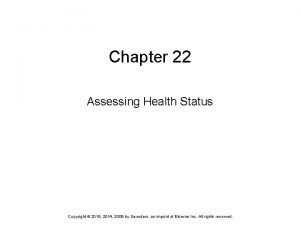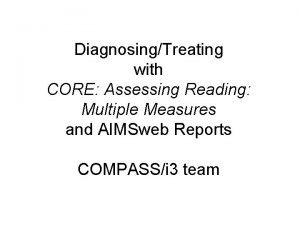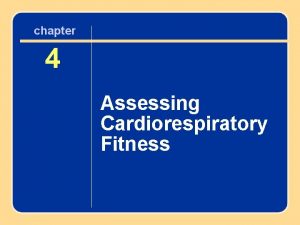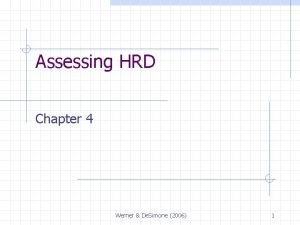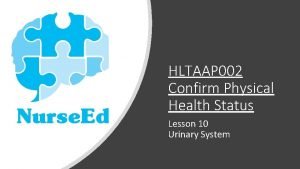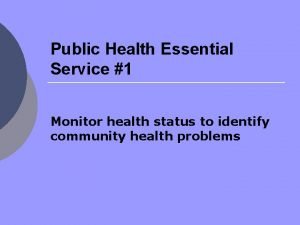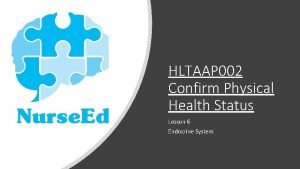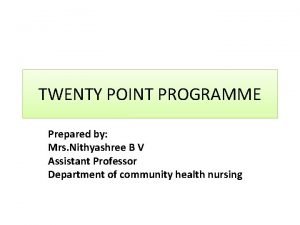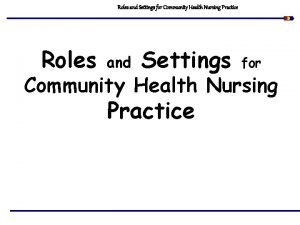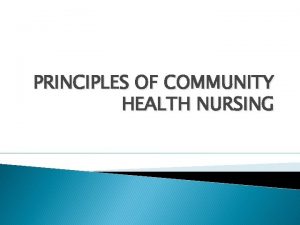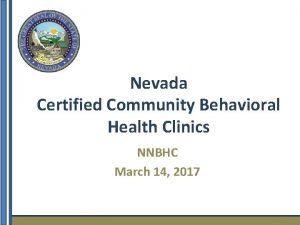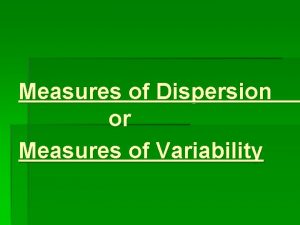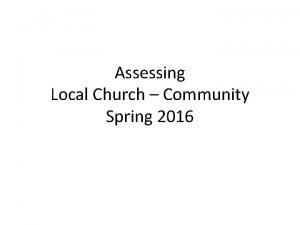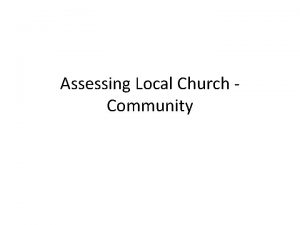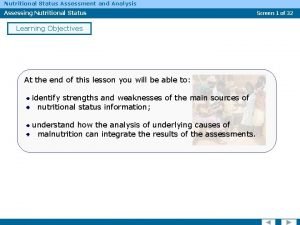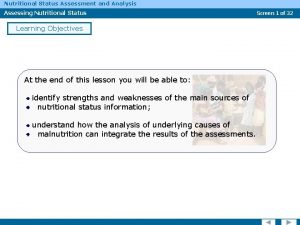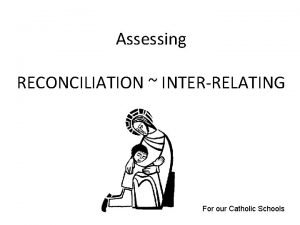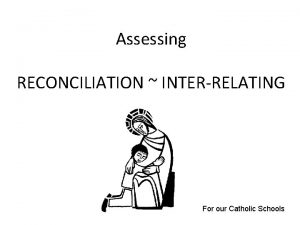Assessing Community Health Measures of Community Health Status


















































- Slides: 50

Assessing Community Health: Measures of Community Health Status and Sources of Population-Based Health Data Don Cibula, Ph. D Assistant Professor, Department of Public Health and Preventive Medicine SUNY Upstate Medical University, Syracuse, New York

Topics Overall Framework: Community Health Assessment • Community health assessment (CHA) – process and purpose • Healthy People 2020 – standards for comparison • Population-based rates and their use in assessment • Types of health status indicators and data sources • Data reliability • Choosing health status indicators for assessment • Interpreting and acting on CHA findings

Community Health Assessment Process and Purpose

Health of Individuals vs. Community Health • Clinical practice – focus on health status and risks of individuals • Ex. of measures: blood pressure (hypertension); body mass index (obesity), behavioral risks (smoking status) • Public health – focus on health status and risks of groups of individuals (communities) • Measures = population-based rates – incidence or prevalence of acute and chronic disease and risk factors, and rates of utilization of preventive care • Ex. of measures: incidence of gonorrhea (per 100, 000 population), prevalence of diabetes (per 100, 000 population), smoking prevalence (per 100 population), mammography as recommended (per 100 females, ages 40+ years)

Definitions of Community • Extent and specificity of definition may be based on questions and concerns being investigated: • Geographic (e. g. residents of urban or rural zip codes) • Life stages (e. g. infants or the elderly) • Gender • Race or ethnicity (e. g. Native Americans or Hispanics) • Socioeconomic (e. g. Medicaid recipients or privately insured) • Chronic conditions (e. g. diabetics or physically disabled) • Immigration status (e. g. Sudanese or Hmong immigrants) • Employment (e. g. seasonal migrant workers or shipyard workers)

Community Health Assessment Process • CHA produces information about health status and needs of a community via an ongoing, systematic process of: • Data collection • Data analysis • Interpretation of results • Distribution of findings

Community Health Assessment Purpose • Purpose: 1. Help inform stakeholders in community health for decision-making: • Planning/implementing interventions • Setting priorities • Coordinating and allocating resources 2. Document need for resources and bolster community commitment and political will to intervene

Community Health Assessment Stakeholders • CHA process should include all stakeholders in a community’s health, e. g. : • Public health agencies • Other health and human service agencies • Hospitals • HMO’s • Legislative and executive bodies of community government • Representative group of community members

Community Health Assessment: A Core PH Function • The Future of Public Health, Institute of Medicine, 1988, identified three core functions for public health: • Assessment • Policy Development • Assurance

*Ten Essential Public Health Services Three are assessment functions: • Monitor health status to identify community health problems • Diagnose and investigate health problems and health hazards in the community • Evaluate effectiveness, accessibility, and quality of personal and population-based health services *Developed by the Future of Public Health Steering Committee, 1994

Healthy People 2020 A National Health Assessment with Objectives

National Health Assessment and Objectives: Healthy People 2020 • Encompassing, collaborative, ongoing effort • Coordinated by CDC • Set of measurable national health objectives • Measures progress over time • A public health reference that presents: • Recommendations for action • A compilation of national public health priorities • Provides US baseline rates and 2020 target rates, which can be used for comparison in state, regional and local health assessments.

Healthy People 2020 • Overarching Goals: • Attain high quality, longer lives free of preventable disease, disability, injury, and premature death. • Achieve health equity, eliminate disparities, and improve the health of all groups. • Create social and physical environments that promote good health for all. • Promote quality of life, healthy development and healthy behaviors across all life stages. • HP 2020 Vision and Mission: • http: //www. healthypeople. gov/HP 2020/Objectives/framework. aspx

Healthy People 2020: Topic Areas • Topic Areas are an organizing framework for sets of related goals, objectives and measures • 38 proposed topic areas, reflecting organization by: • Life-stage (e. g. , Maternal, Infant and Child Health, Early and Middle Childhood, Adolescent Health and Older Adults) • Major groups of chronic and infectious disease (e. g. , Cancer, Heart Disease and Stroke, Diabetes, Immunization and Infectious Diseases, and Sexually Transmitted Diseases)

Healthy People 2020: Topic Areas (Continued) • 38 proposed topic areas, reflecting organization by: • Behavioral determinants (e. g. , Substance Abuse, Tobacco Use, Physical Activity and Fitness, Nutrition and Weight Status) • Social and physical environments (Access to Health Services, Environmental Health, Social Determinants of Health) • Emerging or Evolving Threats and Concerns (Genomics, Food Safety, Healthcare-Associated Infections)

Healthy People 2010: Examples of Objectives • Reduce the proportion of nonsmokers exposed to environmental tobacco smoke. (Baseline 65%, 2010 target 45%) • Increase the proportion of persons with a usual primary care provider. (Baseline 77%, 2010 target 85%)

Healthy People 2020: Health Disparities Types • Geographic disparities • Rural and urban vs. suburban • Racial and ethnic disparities • Economic disparities • e. g. Medicaid vs. private insurance • Social disparities • e. g. college-educated vs. less than HS educated

Healthy People 2010: Disparities Objectives Race Example • Reduce asthma deaths (adults aged 35 to 64 years) Rates are per million population • National baseline: 17. 8 • Black or African American: 52. 3 • White: 13. 3 • 2010 target for all races: 9. 0

Population-Based Rates in Community Health Assessment

Community Health Assessment Indicators • Population-based indicators (measures) of community health status - criteria • Estimations of occurrence of disease and other factors of interest must accurately represent the occurrence in the entire community • The total number of individuals comprising the population of interest must be known

Population vs. Facilities-based Measures • Facilities-based measures are of limited use for community health assessment, because they are rarely representative of the community of interest: • Veterans' Administration records • Nursing home data • Emergency Department data • Private insurance records

Health Status Indicators – Population-based Rates • General construct: rate components • A specified population to which the rate will apply • Individuals affected – numerator • Individuals at risk – denominator • A specified time period, e. g. per year • Multiplier – per 100; 1, 000; 10, 000, 1, 000 individuals in the specified population

Health Status Indicators – Types of Rates • Type is dependent on denominator, i. e. the specified population at risk • Entire population • Rate of accidental deaths per 100, 000 individuals • Subgroups of population • Age, race, and sex-specific rates • Births per 1, 000 Asian-American females aged 15 -17 years • Rates based on events within a population • Vaginal deliveries per 1, 000 women during a year who had a c-section at previous delivery

Health Status Indicators – Age-Adjusted Rates • Used when comparing rates of age-dependent conditions between populations with different age structures (e. g. percentage of elderly residents or females of reproductive age) • Two populations concurrently or single population at different time periods • Example – mortality rate for Alaska vs. Florida, 2010 • Example – US mortality rate in 1960 vs. 2010

Health Status Indicators – Age-Adjusted Rates (Cont. ) • Age-adjustment eliminates age effects by using the observed rates in two populations to derive rates that would be expected if both populations had the same age distributions • The two expected rates are then compared • Use a standard age distribution, e. g. 2000 US Census • Age-adjusted rates generally do not represent the actual incidence or prevalence of disease in either population; they represent artificial constructs – rates scaled (adjusted) to a reference population

Adult Type II Diabetes Prevalence, US, 1980 – 2005 Crude and Age-Adjusted* Rates per 100 Population *Age-adjustment to 2000 US Census population. Source: Centers for Disease Control and Prevention

Community Health Assessment Data Sources for Health Status Indicators

Community Health Assessment Birth-Related Indicators and Sources of Birth Data • Birth measures – Source: National Vital Statistics System • Birth Outcomes • Examples: Method of delivery, complications of delivery, birth weight, gestational age, apgar scores, congenital malformations, NICU admission • Parents’ demographic and socioeconomic data • Examples: Race, maternal age, education level, employment type, medical insurance, participation in federal prenatal care programs

Community Health Assessment Birth-Related Indicators and Sources of Birth Data (Continued) • Birth measures – Source: NVSS (Cont. ) • Mother’s reproductive history • Record of prenatal care • Examples: Dates of last menses and first prenatal care (PNC) visit, number of PNC visits • Medical risk factors • Examples: Gestational diabetes and hypertension, previous poor pregnancy outcomes

Community Health Assessment Birth-Related Indicators and Sources of Birth Data (Continued) • Behavioral risk factors • Examples: Smoking amounts per trimester, alcohol and drug use (self-reported or lab results) • Birth data are available to the public without charge in two forms: • Interactive online queries (examples) http: //wonder. cdc. gov/natality-current. html http: //www. marchofdimes. com/Peristats/ • Downloadable data sets with documentation http: //www. cdc. gov/nchs/data_access/Vitalstatsonline. htm

Community Health Assessment Mortality-Based Indicators and Sources of Data • Mortality measures – Source: National Vital Statistics System • Demographic and socioeconomic data • Examples: Age, sex, residence, education level, employment type • Time, place and manner of death (natural cause, homicide, suicide, accident) • Causes of death • • Immediate cause(s) Intermediate cause(s) Underlying cause(s) Contributing factors

Community Health Assessment Mortality-Based Indicators and Sources of Data (Cont. ) • Like birth data, mortality data are available to the public without charge in two forms: • Interactive online queries (examples) http: //wonder. cdc. gov/ http: //apps. nccd. cdc. gov/DCPC_INCA. aspx • Downloadable data sets with documentation http: //cdc. gov/nchs/data_access/Vital. Stats. Online. htm http: //seer. cancer. gov/data/inde. g. html

Health Status Indicators – Mortality Rates Example: Colorectal Cancer by Race, US, 1969 -2004 Data source: NCHS, National Vital Statistics System

Community Health Assessment Types of Health Status Indicators and Sources of Data • Morbidity measures • Cancer rates – Centralized Cancer (Tumor) Registries coordinated by NIH • Demographics, geographics, tumor type and site, stage, occupation • Infectious disease rates – National Notifiable Diseases Surveillance System • Demographic and geographic information, disease, exposure information, date of report, date of onset of symptoms, occupation

Health Status Indicators – Morbidity Rates Example: Gonorrhea Rates, US, 1941 -2005 Data source: National Notifiable Disease Surveillance System

Community Health Assessment Types of Health Status Indicators and Sources of Data • Morbidity measures (cont. ) • Chronic diseases and medical risk factors and utilization rates (CDC/NCHS) • National Health Interview Survey – self report, telephone interview • Examples: Demographics, family structure, preventive care utilization, behavioral risk factors, insurance status, chronic diseases, medical risk factors, disability status, mental health status

Community Health Assessment Types of Health Status Indicators and Sources of Data • Morbidity measures (cont. ) • Chronic disease and medical risk factor rates (CDC/NCHS) • National Health and Nutrition Examination Survey – physical examinations, measures and lab tests • National Hospital Discharge Survey – chart audit and electronic reporting

Health Status Indicators – Morbidity Rates Example: Percent Population 65+ Yrs. With Chronic Conditions Data source: NHIS, National Health Interview Survey

Community Health Assessment Types of Health Status Indicators and Sources of Data • Behavioral risk factor measures (CDC) • Behavioral Risk Factor Surveillance System – telephone interviews • Examples: Exercise, weight management, nutrition intake, smoking, drinking, preventive care utilization, mental health • Youth Behavioral Risk Factor Surveillance System – form-based, administered in schools • Examples: sexual activity, smoking, drinking, drug use, domestic violence, suicidality, personal safety

Community Health Assessment Types of Health Status Indicators and Sources of Data • Demographic and socioeconomic measures – US Census Bureau • Decennial census and American Community Survey (annually) • Enumeration and estimation of population • Scales: entire US to block level • Attributes: e. g. , age, sex, race, Hispanic origin • Provides basis [denominators] for derivation of population-based rates

Community Health Assessment Types of Health Status Indicators and Sources of Data • Demographic and socioeconomic measures – US Census Bureau (cont. ) • Examples: Measures of poverty, health insurance, employment, family structure, disability, housing characteristics

Health Status Indicators – Socioeconomic Risk Factor Rates Example: Percent Uninsured Children by Poverty Status, Age, Race and Hispanic Origin: 2006 Data Source: U. S. Census Bureau, Current Population Survey, 2006

Community Health Assessment Data Reliability

Community Health Assessment Health Status Indicators – Data Reliability • Examples of potential issues • Reporting error in interviews and selfadministered surveys • Underreporting risk factors, e. g. smoking • Unaware or no recall, e. g. hyperlipidemia, diabetes • Participant does not interpret questions as intended • Example: participant does not identify himself as a smoker because he smokes only on certain social occasions, but this would meet the interviewer’s criteria for being a smoker

Community Health Assessment Health Status Indicators – Data Reliability • Examples of potential issues (cont. ) • Survey participants not representative • Potential participants not contacted due to an impediment/attribute, e. g. : • Participant does not work standard hours, uses unlisted cell phones exclusively, is homeless • Potential participant declines the interview or survey, e. g. : • Language barrier between potential participant and interviewer – incomplete coverage • Voluntary participants are different than nonparticipants – self selection bias

Community Health Assessment Health Status Indicators – Data Reliability • Examples of potential issues (cont. ) • Reporting error in registries and surveillance systems • Common diseases (e. g. Chlamydia) may be underreported • Incomplete reporting due to lack of knowledge of reporting requirements for some diseases • Decision not to report based on doctor-patient or doctorfamily relationship • Ex: AIDS as the underlying cause of death, suicide as a manner of death • Reporting may be more complete in public health care settings than in private settings, resulting in facility/patient-based bias

Community Health Assessment Choosing, Interpreting and Prioritizing Health Status Indicators

Community Health Assessment Criteria for Choosing a Set of Indicators • Non-redundant, but comprehensive set of indicators • e. g. might decide to include only one STD measure • Data are available and are comparable to benchmark or comparison measures • Data are relatively reliable and are generalizable to population(s) of interest

Community Health Assessment Interpreting Indicators • Compare rates from similar localities or regions, state and national rates • Compare benchmark rates: best rate(s) among local subpopulation(s) may be used as benchmark, or may use HP 2020 targets • Consider the demographic and socioeconomic comparability of the populations from which the comparison rates are derived • Examine both recent data and trend data • Examine rates for subpopulations or for smaller areas to reveal local issues that may be masked at larger scales

Community Health Assessment Selected Criteria for Prioritizing Public Health Issues • Absolute prevalence or incidence • Comparative prevalence or incidence • Severity • Leading causes of morbidity, mortality, YPLL, disability years, etc. • Disparities among groups • Increasing trends • Existence of evidence-based intervention or prevention • Gaps in capacity to provide intervention or prevention • Political will in community
 Assessing health status chapter 22
Assessing health status chapter 22 Core graded high frequency word survey
Core graded high frequency word survey Repeated-measures design
Repeated-measures design Community health status indicators
Community health status indicators Btec sport unit 3
Btec sport unit 3 Unit 18 assessing children's development support needs p1
Unit 18 assessing children's development support needs p1 Ways to address grammar in the writing classroom ppt
Ways to address grammar in the writing classroom ppt Difference between ncbts and ppst
Difference between ncbts and ppst Assessing need for hrd
Assessing need for hrd Formal reading assessments
Formal reading assessments Aashto manual for assessing safety hardware
Aashto manual for assessing safety hardware Chapter 4 cultural dynamics in assessing global markets
Chapter 4 cultural dynamics in assessing global markets Assessing a new venture's financial strength and viability
Assessing a new venture's financial strength and viability Assessing cardiorespiratory fitness
Assessing cardiorespiratory fitness Assessing leadership and measuring its effects
Assessing leadership and measuring its effects Many new drivers first fender bender is a backing collision
Many new drivers first fender bender is a backing collision Module 4 topic 1 assessing and managing risk
Module 4 topic 1 assessing and managing risk A nine box matrix requires assessing employees on ________.
A nine box matrix requires assessing employees on ________. Methodology for assessing procurement systems
Methodology for assessing procurement systems While assessing the risks of material misstatement
While assessing the risks of material misstatement Assessing math concepts
Assessing math concepts Assessing motivation to change
Assessing motivation to change Assessing opportunity cost involves
Assessing opportunity cost involves Assessing the situation
Assessing the situation Cultural dynamics in assessing global markets
Cultural dynamics in assessing global markets Assessing value for money
Assessing value for money Parental capacity example
Parental capacity example Group discussion images
Group discussion images Chapter 4 values, attitudes and job satisfaction
Chapter 4 values, attitudes and job satisfaction Cultural dynamics in assessing global markets
Cultural dynamics in assessing global markets Assessing the internal environment of the firm
Assessing the internal environment of the firm Assessing hrd needs
Assessing hrd needs Role and responsibility of occupational health nurse
Role and responsibility of occupational health nurse Hltaap002 confirm physical health status
Hltaap002 confirm physical health status Monitor health status
Monitor health status Hyperthyroidism
Hyperthyroidism How can random events affect health status
How can random events affect health status Pc health status
Pc health status Community action cycle
Community action cycle Lenawee county cmh
Lenawee county cmh Van buren community mental health
Van buren community mental health Twenty point programme was launched in the year
Twenty point programme was launched in the year Evaluation in nursing process
Evaluation in nursing process Nursing diagnosis as evidenced by
Nursing diagnosis as evidenced by Community settings main roles
Community settings main roles Principles of community nursing
Principles of community nursing Define nursing process
Define nursing process Psychiatric nursing diagnosis
Psychiatric nursing diagnosis Ccbhc nevada
Ccbhc nevada Objectives of community mental health
Objectives of community mental health Family and community health advisor
Family and community health advisor
